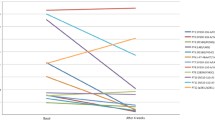Summary
In a previous study, Dutch children with phenylketonuria (PKU) were found to be slightly shorter than their healthy counterparts. In the literature, it has been hypothesized that a higher protein intake is necessary to optimize growth in PKU patients. The study aimed to investigate whether protein intake (total, natural and protein substitute) in this group might be an explanatory factor for the observed growth. Growth of height and head circumference and dietary data on protein intake (total, natural and protein substitute) from 174 Dutch PKU patients born between 1974 and 1996 were analysed retrospectively for the patients' first 3 years of life. Analyses were corrected for energy intake during the first year of life and for the clinical severity of the deficiency of phenylalanine hydroxylase by means of plasma phenylalanine concentration at birth. Neither protein nor energy intake correlated with height growth. A positive, statistically significant relation between head circumference growth and natural protein and total protein intake was found, but not with the intake of the protein substitute or energy. Therefore, this study suggests that improvement of the protein substitute rather than an increase of total protein intake may be important in optimizing head circumference growth in PKU patients.
Similar content being viewed by others
References
Acosta PB (1996) Recommendations for protein and energy intakes by patients with phenylketonuria. Eur J Pediatr 155(Supplement 1): S121–S124.
Acosta PB, Yannicelli S (1994) Protein intake affects phenylalanine requirements and growth of infants with phenylketonuria. Acta Paediatr 407(Supplement): 66–67.
Acosta PB, Wenz RD, Williamson M (1977) Nutrient intake of treated infants with phenylketonuria. Am J Clin Nutr 30: 198–208.
Acosta PB, Yannicelli S, Marriage B (1998) Nutrient intake and growth of infants with phenylketonuria undergoing therapy. J Pediatr Gastroenterol Nutr 27: 287–291.
Anonymous (1971) Malnutrition with early treatment of phenylketonuria. Nutr Rev 29: 11–13.
Carver JD, Wu PY, Hall RT, et al (2001) Growth of preterm infants fed nutrient-enriched or term formula after hospital discharge. Pediatrics 107: 683–689.
Chang P, Weisberg S, Fisch RO (1984) Growth development and its relationship to intellectual functioning of children with phenylketonuria. J Dev Behav Pediatr 5: 127–131.
Cockburn F, Clark BJ, Caine EA, et al (1996) Fatty acids in the stability of neuronal membrane: relevance to PKU. Int Pediatr 1: 56–60.
Dewey GK, Beaton G, Fjeld C, Lönnerdal B, Reeds P (1996) Protein requirements of infants and children. Eur J Clin Nutr 50(Supplement 1): S119–150.
Dobbelaere D, Michaud L, Debrabander A, et al (2003) Evaluation of nutritional status and pathophysiology of growth retardation in patients with phenylketonuria. J Inherit Metab Dis 26: 1–11.
Dolk H (1991) The predictive value of microcephaly during the first year of life for mental retardation at seven years. Dev Med Child Neurol 33: 974–983.
Fomon SJ (1991) Requirements and recommended dietary intakes of protein during infancy. Pedriatr Res 30: 391–395.
Fredriks AM, van Buuren S, Burgmeijer RJ, et al (2000) Continuing positive secular growth change in The Netherlands 1955–1997. Pediatr Res 47: 316–323.
Giovannini M, Biasucci G, Agostoni C, Luotti D, Riva E (1995) Lipid status and fatty acid metabolism in phenylketonuria. J Inherit Metab Dis 18: 265–272.
Gropper SS, Acosta PB (1991) Effect of simultaneous ingestion of L-amino acids and whole protein on plasma amino acid and urea nitrogen concentrations in humans. J Parenter Enteral Nutr 15: 48–53.
Herrmann ME, Brosicke HG, Keller M, Monch E, Helge H (1994) Dependence of the utilization of a phenylalanine-free amino acid mixture on different amounts of single dose ingested. A case report Eur J Pediatr 153: 501–503.
Huijbregts SCJ, de Sonneville LMJ, van Spronsen FJ, et al (2003) Motor function under lower and higher controlled processing demands in early and continuously treated phenylketonuria. Neuro- psychology 17: 369–379
Kindt E, Lunde HA, Gjessing LR, et al (1988) Fasting plasma amino acid concentrations in PKU children on two different levels of protein intake. Acta Paediatr Scand 77: 60–66.
Lindley AA, Benson JE, Grimes C, Cole IM, Herman AA (1999) The relationship in neonates between clinically measured head circumference and brain volume estimated from head CT-scans. Early Hum Dev 56: 17–29.
McCabe L, Ernest AE, Neifert MR, et al (1989) The management of breast feeding among infants with phenylketonuria. J Inherit Metab Dis 12: 467–474.
Przyrembel H (1996) Recommendations for protein and amino acid intake in phenylketonuria patients. Eur J Pediatr 155(Supplement 1): S130–S131.
Räihä N, Minoli I, Moro G (1986) Milk protein intake in the term infant. I. Metabolic responses and effects on growth. Acta Paediatr Scand 75: 881–886.
Schaeffer F, Burgard P, Bazler U, et al (1994) Growth and skeletal maturation in children with phenylketonuria. Act Paediatr 83: 534–541.
Scriver CR, Kaufman S (2001) Hyperphenylalaninemia: phenylalanine hydroxylase deficiency. In: Scriver CR, Beaudet AL, Sly WS, Valle D, eds; Childs B, Kinzler KW, Vogelstein B, assoc. eds. The Metabolic and Molecular Bases of Inherited Disease, 8th edn. New York: McGraw-Hill, 1667–1724.
van Spronsen FJ, Verkerk PH, van Houten M, et al (1997) Does impaired growth of PKU patients correlate with the strictness of dietary treatment? Acta Paediatr 86: 816–818.
Verkerk PH, van Spronsen FJ, Smit GPA, Sengers RCA (1994) Impaired prenatal and postnatal growth in Dutch patients with phenylketonuria. Arch Dis Child 71: 114–118.
Watemberg N, Silver S, Harel S, Lernam-Sagie T (2002) Significance of microcephaly among children with developmental disabilities. J Child Neurol 17: 117–122.
Xiang M, Alfven G, Blennow M, Trygg M, Zetterstrom R (2000) Long-chain polyunsaturated fatty acids in human milk and brain growth during early infancy. Acta Paediatr 89: 142–147.
Author information
Authors and Affiliations
Corresponding author
Rights and permissions
About this article
Cite this article
Hoeksma, M., Van Rijn, M., Verkerk, P.H. et al. The intake of total protein, natural protein and protein substitute and growth of height and head circumference in Dutch infants with phenylketonuria. J Inherit Metab Dis 28, 845–854 (2005). https://doi.org/10.1007/s10545-005-0122-x
Received:
Accepted:
Issue Date:
DOI: https://doi.org/10.1007/s10545-005-0122-x




